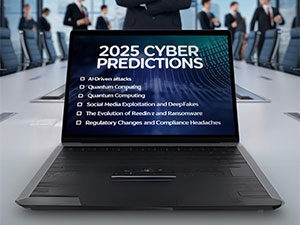Cyberthreats are advancing at an unprecedented rate, turning yesterday’s science fiction into today’s reality. From AI-powered cyber-attacks to quantum computing breakthroughs, 2025 promises both incredible innovation and alarming new risks. Here’s what small and medium-sized businesses (SMBs) should prepare for in the coming year—and how to stay ahead of the curve.
1. AI-Driven Attacks: Smarter, Faster, and More Elusive
Artificial intelligence (AI) has become a game-changer for cybercriminals. Hackers are leveraging AI to automate and enhance their attacks, creating hyper-targeted phishing emails, self-evolving malware, and attack patterns that outpace traditional defenses.
How to Prepare:
- Invest in cybersecurity tools that use machine learning to identify and stop AI-driven threats.
- Train employees to spot AI-enhanced phishing emails, which are often highly personalized and convincing.
- Combine technology with human vigilance for a proactive approach to defending against AI-powered cyberattacks.
2. Quantum Computing: A Looming Threat to Encryption
Quantum computing is making rapid strides, and by 2025, it could begin to undermine the encryption standards we rely on today. Unlike classical computers, quantum computers use qubits to perform complex calculations at unprecedented speeds, potentially cracking even the strongest encryption algorithms.
How to Prepare:
- Start exploring quantum-resistant encryption technologies to future-proof your business.
- Work with IT providers to create a roadmap for transitioning to post-quantum cryptography.
- Monitor advancements in quantum computing to stay informed about its implications for data security.
3. Social Media Exploitation and Deepfakes: Rising Misinformation Threats
Social media remains a hotbed for cybercrime. In 2025, expect an increase in the use of deepfakes—fake but convincing video and audio content—to manipulate trust and execute social-engineering attacks. Cybercriminals will also exploit social media to spread misinformation and deceive businesses.
How to Prepare:
- Foster a culture of skepticism and verification within your organization.
- Train employees to recognize deepfake technology and validate unexpected requests, even if they appear legitimate.
- Use multi-factor authentication and other verification tools to confirm identities during critical transactions or communications.
4. Ransomware Evolves: The Era of Double Extortion
Ransomware attacks are no longer just about locking down data. In 2025, double extortion will be the norm—hackers not only encrypt data but also threaten to expose sensitive information if the ransom isn’t paid. Critical sectors like healthcare, infrastructure, and supply chains are particularly at risk.
How to Prepare:
- Develop a robust incident-response plan with clear steps for ransomware recovery.
- Implement secure, off-network backups and test them regularly to ensure quick recovery.
- Invest in threat detection tools that identify ransomware attempts before they cause damage.
5. Regulatory Changes: Compliance Is Non-Negotiable
As cyberthreats grow, so do government regulations. By 2025, businesses will face stricter rules for data protection, privacy, and incident response. Non-compliance can lead to significant fines and reputational damage, particularly for SMBs operating across multiple jurisdictions.
How to Prepare:
- Designate a compliance officer or partner with an IT consultant to track regulatory changes.
- Integrate compliance measures into your cybersecurity strategy, ensuring all policies and procedures meet legal requirements.
- Conduct regular audits to stay ahead of compliance issues and bolster your overall security posture.
Conclusion: Stay Ahead of 2025’s Cybersecurity Challenges
Cyberthreats are advancing, but so are the tools and strategies to combat them. By proactively addressing the risks posed by AI-driven attacks, quantum computing, ransomware, and more, SMBs can stay protected and resilient.
Start preparing today:
- Invest in AI-powered defenses.
- Explore quantum-resistant encryption options.
- Train your team to recognize new threats like deepfakes and social engineering scams.
- Strengthen your ransomware recovery and compliance efforts.
Concerned about your cybersecurity readiness? Contact us for a FREE Security Risk Assessment to evaluate your current defenses and develop a plan for the future. Call 214-550-0550 or click here to schedule your assessment today!

